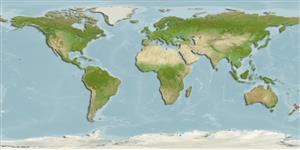Environment: milieu / climate zone / depth range / distribution range
Ökologie
seewasser riff-verbunden; tiefenbereich 0 - 30 m (Ref. 9003). Subtropical; 29°S - 47°S
Southwest Pacific: Australia and New Zealand.
Size / Gewicht / Alter
Maturity: Lm ? range ? - ? cm
Max length : 40.0 cm SL Männchen/unbestimmt; (Ref. 9002)
Rückenflossenstacheln (insgesamt) : 14 - 15; Rückenflossenweichstrahlen (insgesamt) : 16 - 20; Afterflossenstacheln: 3; Afterflossenweichstrahlen: 6 - 8; Wirbelzahl: 33. Adults have evenly spaced white spots over the entire head and body (Ref. 33616).
Commonly found in kelp and weed areas of shallow rocky reefs exposed to strong surge and wave action (Ref. 33616). Feed on invertebrates and small fishes (Ref. 9003).
Life cycle and mating behavior
Geschlechtsreife | Fortpflanzung | Ablaichen | Eier | Fecundity | Larven
Paulin, C. and C. Roberts, 1992. The rockpool fishes of New Zealand (Te ika aaria o Aotearoa). Museum of New Zealand (Te Papa Tongarewa). 177 p. (Ref. 9003)
IUCN Rote Liste Status (Ref. 130435: Version 2024-1)
Bedrohung für Menschen
Harmless
Nutzung durch Menschen
Tools
Zusatzinformationen
Download XML
Internet Quellen
Estimates based on models
Preferred temperature (Ref.
123201): 14.5 - 22.2, mean 17.6 °C (based on 132 cells).
Phylogenetic diversity index (Ref.
82804): PD
50 = 0.5312 [Uniqueness, from 0.5 = low to 2.0 = high].
Bayesian length-weight: a=0.01000 (0.00381 - 0.02627), b=3.05 (2.83 - 3.27), in cm total length, based on LWR estimates for this (Sub)family-body shape (Ref.
93245).
Trophic level (Ref.
69278): 3.7 ±0.2 se; based on diet studies.
Fishing Vulnerability (Ref.
59153): Moderate vulnerability (39 of 100).
Nutrients (Ref.
124155): Calcium = 33.6 [16.7, 65.2] mg/100g; Iron = 0.641 [0.377, 1.066] mg/100g; Protein = 20 [19, 21] %; Omega3 = 0.202 [0.118, 0.335] g/100g; Selenium = 15.9 [7.8, 30.4] μg/100g; VitaminA = 39.1 [13.8, 117.1] μg/100g; Zinc = 0.865 [0.579, 1.263] mg/100g (wet weight);
